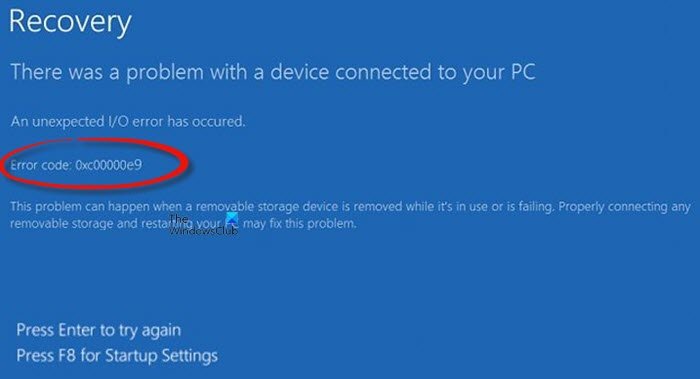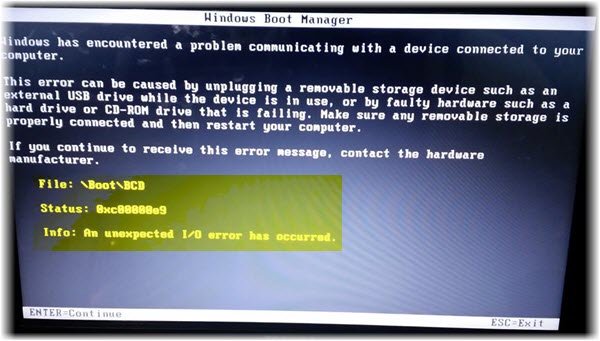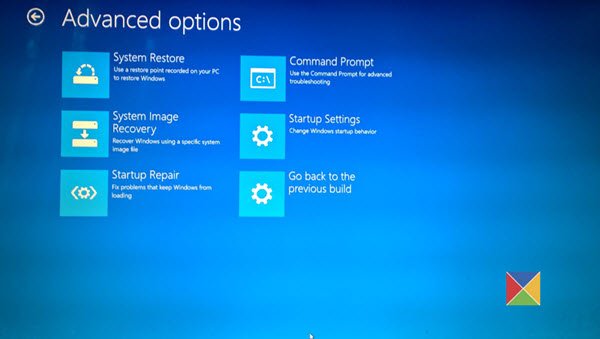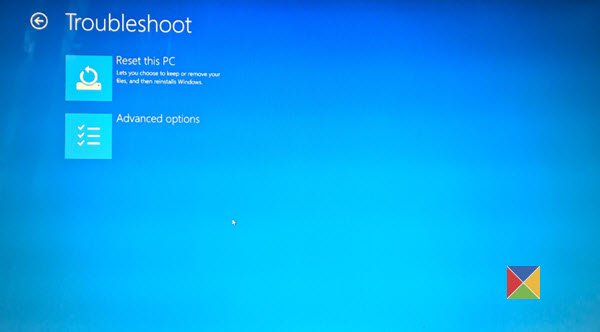Windows users could face a very problematic situation at times. They may be unable to load the operating system at all, and the only keys that may work are F2 and F12. During startup, Windows Boot Manager may display the following error message:
Windows has encountered a problem communicating with a device connected to your computer, File \Boot\BCD, Error code: 0xc00000e9, An unexpected I/O error has occurred.

This problem can occur when a removable storage device is removed while it’s in use or it is failing. Properly connecting any removable storage and restarting your PC may fix this problem. It can also occur if a corrupted system file is encountered during the boot process.
The usual causes are:
- Corrupt Windows files or Registry
- Failing external hardware or PC components
- Damaged I/O ports
- A disconnected hard drive that doesn’t connect with the motherboard
- Improperly configured UEFI, BIOS, or CMOS settings.

Since the system is booting in the Recovery Mode, there are limited options that could help us. If it is genuinely a problem with the hardware, the system would have to be repaired by a computer technician, but usually, the fix mentioned in this article could be of help. The reason is that the issue usually involves detachable drives, mostly the USB. Thus, if we remove the USB drives and see. If this does not help, you may need to troubleshoot further.
An unexpected I/O Error has occurred, Error code 0xc00000e9
Since the only mode you can use is the recovery mode, try booting the system with the recovery drive or the Windows Installation Media. Some laptops have an assist button to load the page for recovery options.
If you are running Windows 11/10, you may boot into Advanced Startup Options. Once you have done this, the options available to fix this issue are as follows:
1] Perform Startup Repair

On the Advanced options screen, you may choose to perform Startup Repair.
Allow the process to diagnose and repair your system, and hopefully, it will boot normally.
1] Run ChkDsk in Safe mode
Boot Windows into Safe Mode, open Command prompt, and run the ChkDisk tool to fix disk errors.
You may also need to check your hard drive for any bad sectors or other problems. You need to run a series of Hard drive diagnostic. Follow this article to Scan and Fix Hard Drive Bad Sectors.
3] Corrupted or bad partition
Sometimes the partition you choose to install might be corrupted or bad. Or maybe that particular partition might not be visible when you try to install it.
In such cases, you need to format the partition. So my advice would be to backup your data to an external drive or some other source and then delete the partition and reformat it.
For some reason if you’re not able to get into Windows, then download a Bootable CD and burn it into a disk. Using these tools is fairly simple; just follow the wizard. The website also has tutorials on how to delete a partition and format it.
Once you complete these, try to install it again and see if it works.
2] Repair the Master Boot Record
If your Windows cannot boot, you will have to again boot into Advanced Startup Options and select the Command Prompt option, which you can see in the above Advanced Options screen image
Next, run the following command one by one to repair MBR:
BOOTREC /SCANOS BOOTREC /FIXMBR BOOTREC /FIXBOOT BOOTREC /REBUILDBCD
If all the commands execute successfully, restart the system. Usually, it should fix the problem.
5] False Positive Check

If you see this error during Installation then this suggestion may apply. 0xc00000e9 means that something is wrong with your hard drive – but sometimes the error could just be a false positive – i.e. it may be something else. So first check the consistency of your installation media. To do so, download MD5 Hash Checker and install it.
MD5sum hash check is a utility that checks if you had a bad ISO image when you burned it to disk. Microsoft has published the Md5sum hash on the download page of Windows. So compare that value with the file you have downloaded and make sure the Md5sum hash value matches.
There are also other tools available specific to hard drive manufacture so check their website for more troubleshooting tips on fixing hard drives.
3] Re-install Windows using Reset This PC option

You will have to again boot to Startup Options and then from the Troubleshoot screen select Reset this PC. Make sure that you opt to keep the files and data when you are asked.
Let us know if any of this helped.
See this post if you receive The I/O operation has been aborted because of either a thread exit or an application request error.
Buenas tardes, se ha presentado un problema con mi sistema, yo tengo una Dell inspiron n5010 con Windows 7 profesional, antes pude realizar la instalación de Windows 10 hace como 3 meses, luego volví a Windowsy7, ahora quiero hacer una instalación nuevamente de Windows 10, sinembargo cada vez que inicio el dvd me dirige a recovery diciendo que tengo un error de la unidad extraíble, he reiniciado, he tratado de instalar por Windows pero me dice que setup no está programado para ejecutarse en Windows, y en vez de dirigirme directo a la instalación del sistema operativo como siempre hago, me manda a recovery con el mismo problema, n veces lo haga me sale lo mismo. Que puedo hacer?
Mi correo es Edmayko@live.com
Gracias de antemano
Many thanks, worked like a charm.